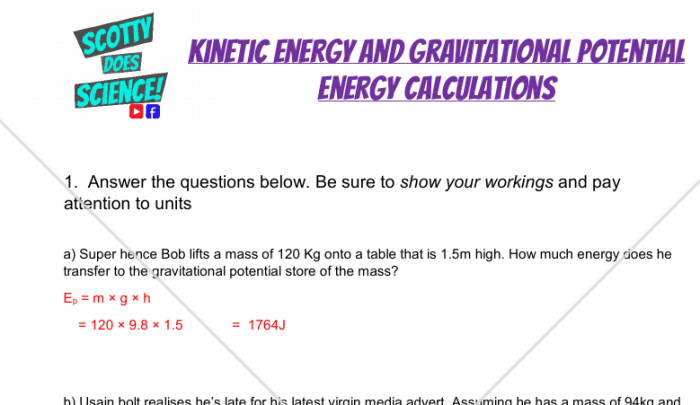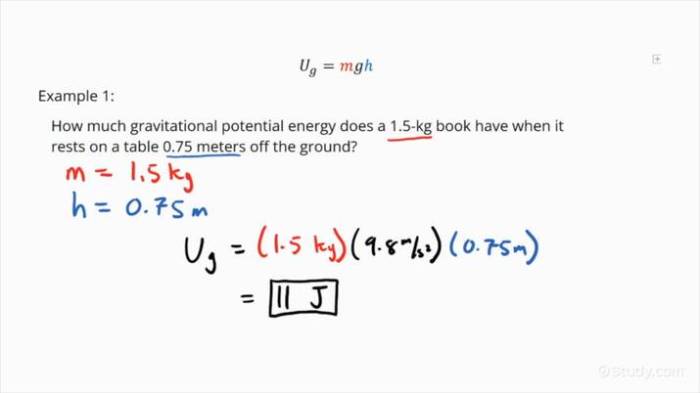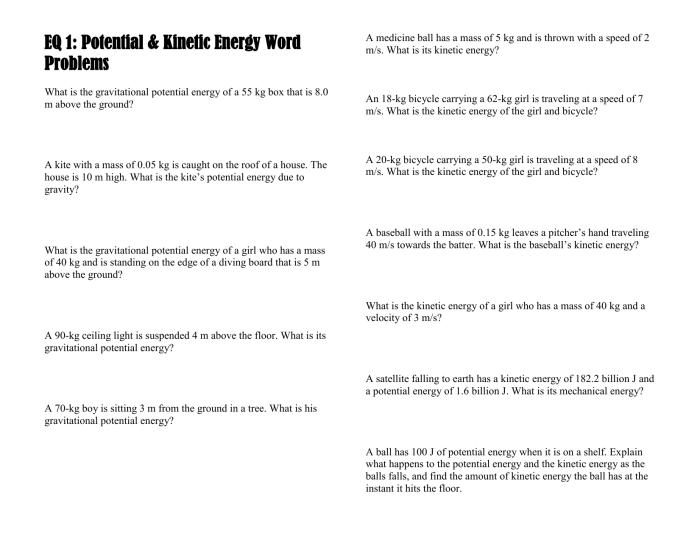Gpe and ke word problems – Embark on an enlightening journey into the realm of gravitational potential energy (GPE) and kinetic energy (KE), where we unravel the mysteries of energy in motion. These fundamental concepts, intertwined in a captivating dance, play a pivotal role in shaping our physical world.
Through engaging word problems, we will explore the intricacies of GPE and KE, their interplay, and their practical applications. Prepare to be captivated as we delve into the depths of energy transformation, uncovering the secrets that govern the movement of objects around us.
GPE Word Problems

Gravitational potential energy (GPE) measures the energy an object possesses due to its position within a gravitational field. In word problems, GPE is often calculated for objects at different heights or distances from the Earth’s surface.
Problem-Solving Strategies
- Identify the given variables: mass (m), height (h), and acceleration due to gravity (g).
- Apply the GPE formula: GPE = mgh, where m is in kilograms, h is in meters, and g is 9.8 m/s² on Earth.
Examples
- A 10 kg ball is held 2 meters above the ground. What is its GPE?
- A car of mass 1500 kg is parked on a hill 50 meters high. What is its GPE?
KE Word Problems: Gpe And Ke Word Problems

Kinetic energy (KE) is the energy possessed by an object due to its motion. It is directly proportional to the object’s mass and the square of its velocity.
KE word problems often involve determining the KE of an object given its mass and velocity or calculating the velocity of an object given its KE and mass. Solving these problems requires using the formula for KE: KE = 1/2 – m – v^2, where KE is kinetic energy, m is mass, and v is velocity.
GPE and KE word problems can be tricky, but with practice, you’ll get the hang of them. If you’re looking for some extra help, I recommend checking out the Wordly Wise 3000 Book 3 . It’s a great resource for building vocabulary and improving reading comprehension.
Once you’ve mastered the basics, you’ll be able to solve GPE and KE word problems like a pro!
Solving KE Word Problems
To solve KE word problems, follow these steps:
- Identify the given information and what is being asked.
- Determine which variables are known and which are unknown.
- Substitute the known values into the KE formula.
- Solve for the unknown variable.
Comparing GPE and KE
Gravitational potential energy (GPE) and kinetic energy (KE) are two fundamental forms of mechanical energy. They are similar in that they both represent the energy of an object due to its position or motion. However, they also have some key differences.
One of the main differences between GPE and KE is the way they are calculated. GPE is calculated using the formula GPE = mgh, where m is the mass of the object, g is the acceleration due to gravity, and h is the height of the object above a reference point.
KE, on the other hand, is calculated using the formula KE = 1/2mv^2, where m is the mass of the object and v is its velocity.
Another difference between GPE and KE is the units in which they are measured. GPE is measured in joules (J), while KE is also measured in joules. However, the units of GPE and KE can be converted into each other using the formula 1 J = 1 kg m^2/s^2.
Finally, GPE and KE have different applications. GPE is often used to calculate the potential energy of an object that is stored due to its position. For example, the GPE of a ball that is held above the ground can be used to calculate the speed of the ball when it is dropped.
KE, on the other hand, is often used to calculate the kinetic energy of an object that is moving. For example, the KE of a car can be used to calculate the distance the car will travel when it brakes.
Table Comparing GPE and KE
| Property | GPE | KE |
|---|---|---|
| Formula | GPE = mgh | KE = 1/2mv^2 |
| Units | Joules (J) | Joules (J) |
| Applications | Calculating the potential energy of an object due to its position | Calculating the kinetic energy of an object that is moving |
Converting Between GPE and KE
In some cases, it is necessary to convert between GPE and KE. For example, if you know the GPE of an object, you can use the formula KE = GPE to calculate the KE of the object. Similarly, if you know the KE of an object, you can use the formula GPE = KE to calculate the GPE of the object.
Here is an example of how to convert between GPE and KE:
- A ball with a mass of 1 kg is held 10 m above the ground. What is the GPE of the ball?
- GPE = mgh = (1 kg)(9.8 m/s^2)(10 m) = 98 J
- If the ball is dropped, what is its KE just before it hits the ground?
- KE = GPE = 98 J
Applications of GPE and KE in Real-World Situations

Gravitational potential energy (GPE) and kinetic energy (KE) are fundamental concepts in physics that find widespread applications in various real-world situations. Understanding these forms of energy is crucial for analyzing and predicting physical phenomena in fields such as engineering, sports, and transportation.
Engineering
- Bridge design:Engineers use GPE to calculate the potential energy stored in a bridge’s structure. This information helps them determine the maximum load the bridge can withstand before collapsing.
- Dam construction:The GPE of water behind a dam is converted into KE as it flows through the dam’s turbines, generating electricity.
- Roller coasters:The KE of a roller coaster car is determined by its speed and height above the ground. Engineers use this information to design the track and ensure a safe and thrilling ride.
Sports, Gpe and ke word problems
- High jump:Athletes convert their KE into GPE as they run and jump, reaching a maximum height. The GPE is then converted back into KE as they fall.
- Javelin throw:The KE imparted to the javelin by the athlete is converted into GPE as it rises in the air. The GPE is then converted back into KE as it falls.
- Cycling:Cyclists use KE to accelerate and climb hills. They also use GPE to coast downhill, converting their potential energy into KE.
Transportation
- Automotive engineering:Engineers design vehicles to minimize energy loss due to friction and air resistance, ensuring efficient conversion between KE and GPE.
- Space travel:Rockets use a combination of GPE and KE to achieve orbit and travel through space.
- Elevators:The KE of an elevator’s motor is converted into GPE as it lifts the elevator up the shaft. The GPE is then converted back into KE as the elevator descends.
Q&A
What is the difference between GPE and KE?
GPE is the energy an object possesses due to its position within a gravitational field, while KE is the energy an object possesses due to its motion.
How can I solve GPE word problems?
To solve GPE word problems, identify the given variables (mass, height, and gravitational acceleration) and apply the formula: GPE = mgh.
How can I convert between GPE and KE?
In the absence of friction, the conversion between GPE and KE is lossless. The formula for conversion is: GPE = KE.